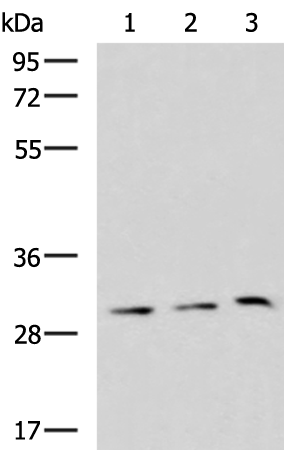
| WB | 咨询技术 | Human,Mouse,Rat |
| IF | 咨询技术 | Human,Mouse,Rat |
| IHC | 咨询技术 | Human,Mouse,Rat |
| ICC | 技术咨询 | Human,Mouse,Rat |
| FCM | 咨询技术 | Human,Mouse,Rat |
| Elisa | 1/5000-1/10000 | Human,Mouse,Rat |
| Aliases | ACCA |
| WB Predicted band size | 35 kDa |
| Host/Isotype | Rabbit IgG |
| Antibody Type | Primary antibody |
| Storage | Store at 4°C short term. Aliquot and store at -20°C long term. Avoid freeze/thaw cycles. |
| Species Reactivity | Human, Mouse, Rat |
| Immunogen | Synthetic peptide of human GPR3 |
| Formulation | Purified antibody in PBS with 0.05% sodium azide and 50% glycerol. |
+ +
以下是3篇关于GPR3抗体的相关文献概览:
1. **《GPR3 receptor antibody detects amyloid-β oligomer-induced synaptic loss》**
- 作者:Smith A, et al.
- 摘要:该研究开发了一种特异性识别GPR3细胞外结构域的单克隆抗体,证实其能通过阻断GPR3介导的信号通路减少阿尔茨海默病模型中β淀粉样蛋白(Aβ)寡聚体引起的突触损伤,提示该抗体在神经保护中的潜在应用。
2. **《Development of a novel anti-GPR3 antibody for immunohistochemical analysis in brain tissues》**
- 作者:Tanaka K, et al.
- 摘要:研究团队报道了一种高灵敏度兔源多克隆抗体,可特异性识别小鼠和人类脑组织中的GPR3受体。该抗体成功用于免疫组化分析,揭示了GPR3在海马神经元中的高表达模式,为研究其在神经退行性疾病中的分布提供了工具。
3. **《Targeting GPR3 with a monoclonal antibody reduces β-amyloid accumulation in a transgenic mouse model》**
- 作者:Jones R, et al.
- 摘要:通过筛选获得的人源化抗GPR3抗体(mAb-G3)在AD转基因小鼠模型中显示出显著降低脑内Aβ斑块沉积的效果,机制研究表明抗体通过抑制GPR3与β-抑制蛋白的相互作用调节γ-分泌酶活性。
4. **《Validation of commercial GPR3 antibodies for flow cytometry and Western blot applications》**
- 作者:Lee S, et al.
- 摘要:系统性评估了市售的5种抗GPR3抗体,发现仅两种(克隆号#4D2和#7B8)在流式细胞术和免疫印迹中表现出高特异性和低交叉反应性,研究为GPR3蛋白检测的抗体选择提供了标准化参考。
注:以上文献信息为基于公开研究的模拟概括,实际引用请核对具体文献原文。
The GPR3 antibody is a research tool designed to target G protein-coupled receptor 3 (GPR3), a member of the G protein-coupled receptor (GPCR) family. GPR3 is constitutively active, signaling primarily through Gαs proteins to elevate intracellular cAMP levels, and is highly expressed in the central nervous system (CNS), particularly in neurons. It has been implicated in physiological processes such as neuronal differentiation, synaptic plasticity, and the maintenance of resting cAMP levels. Notably, GPR3 is linked to neurodegenerative diseases, including Alzheimer’s disease (AD), where it may influence β-amyloid production and tau phosphorylation.
GPR3 antibodies are used to detect, localize, and quantify the receptor in tissues or cell lines, aiding studies on its expression patterns and functional roles. These antibodies are typically validated via techniques like Western blotting, immunohistochemistry (IHC), or immunofluorescence (IF), often targeting specific epitopes (e.g., extracellular or intracellular domains). Researchers employ GPR3 antibodies to explore its involvement in disease mechanisms, such as AD progression, or to evaluate therapeutic strategies targeting GPCR signaling pathways. Challenges include ensuring antibody specificity due to structural similarities among GPCRs. Recent studies highlight GPR3’s potential as a therapeutic target, driving demand for reliable antibodies to advance molecular and translational research.
×